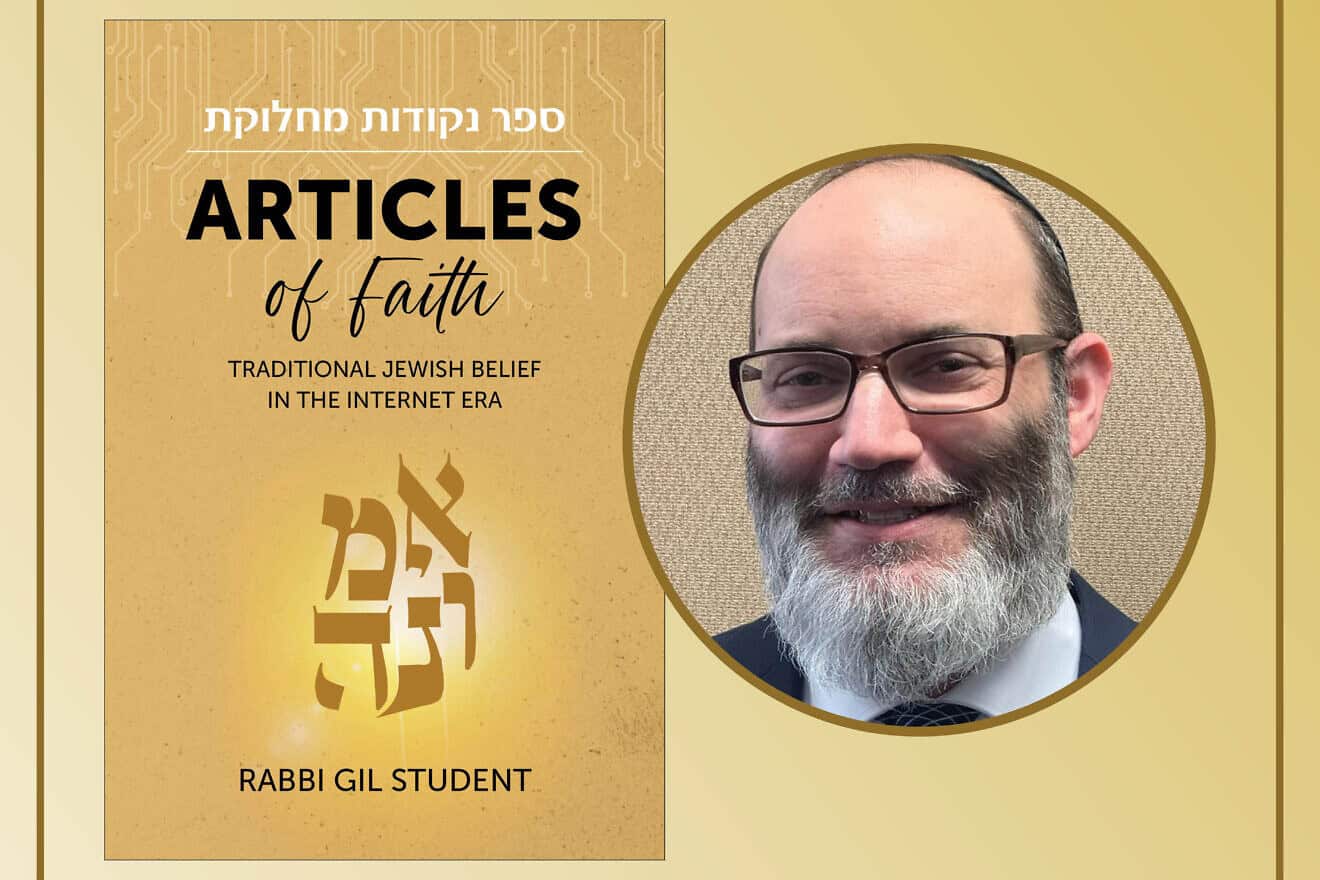Rabbi Gil Student’s new book, Articles of Faith: Traditional Jewish Belief in the Internet Era (Kodesh Press, 2024), is a thoughtful exploration of contemporary Orthodox Jewish belief in the face of modern challenges, including discussions about faith, technology and community within Judaism. Based on traditional interpretations of Talmudic texts, commentaries, codes and responsa, Student addresses some of the crucial questions facing us today, particularly as they emerge from quickly evolving technology.
Student’s name may be familiar to readers of Jewish newspapers and magazines but his rise to prominence began with the 2004 founding of his blog “Torah Musing,” then called Hirhurim, which was one of the first online forums where Judaism could be discussed with intellectual and religious seriousness. It was a place where rabbis, scholars, lay leaders and other committed Jews could discuss and debate religious ideas at a high level. The book begins with a history of the blog, so readers can appreciate the growth and interaction of Torah on the Internet as Torah Musings celebrates its 20th anniversary.
One of the surprisingly troubling issues in the Jewish world today is the widespread knowledge of Torah thanks to the Internet, a seeming blessing with hidden challenges. In the middle of the 16th century, Gutenberg’s popularization of the printing press led to a vast increase in literacy and an explosion of knowledge. It was perhaps the greatest single advancement in human knowledge, that is, until the Internet. From a Jewish perspective, the Internet is a mixed blessing indeed. Student takes an honest account of its undeniable benefits: numerous Jewish websites have shiurim (lessons) that can be streamed for free. Texts that were once obscure can be accessed at the speed of light. Blogs and social media groups host ongoing discussions of contemporary religious issues. And on many religious websites, there is an option to chat with a rabbi about any halachic (Jewish law) or hashkafic (philosophical) topic imaginable.
But there is a dark side to the web. We are not discussing here the many inappropriate images or the like that appear online, although they pose a formidable danger. Nor are we addressing the constant distraction the Internet can pose from overuse. Rather, the unspoken threat of the Internet is the cynicism it can generate from the easy exposure to alternative viewpoints and condescending voices. People become so-called experts overnight on topics that it takes a lifetime to master. A superficial knowledge can sometimes be worse than ignorance. Online, people encounter poisonous attitudes of skepticism and disdain, intolerance and arrogance. Few things are more harmful to the soul than cynicism. It corrodes faith in others, faith in leaders, faith in God.
Student discusses many important topics of faith in this book—the importance of the “13 principles of Jewish Belief,” the primacy of the Bible’s sacred origins contrary to the challenges of biblical critics, the attitude to science among the Talmudic sages and much more.
Perhaps the most important subject is this specific faith challenge posed by the Internet, the corrosive cynicism it can engender. The answer to cynicism cannot be banning the Internet, which will not work and will only generate more cynicism. The answer has to be increased respect. When we show respect to elders and experts, when rabbis act and speak respectfully, especially to those with whom they disagree, and when we emphasize the importance of positivity we will put a stop to cynicism. We must model proper behavior and make it standard in the community. The humility and respect we express will generate respect and deference, love and reverence, from those who may be tempted by the corrosive nature of the Internet.
While this may generally counter the effects of cynicism, Student also suggests educational responses to this great skepticism and cynicism of our age. How do we nurture faith amid the current reign of confusion and negativity? Drawing on the teachings of two influential 19th-century rabbis, he argues that we must take the tools of secularism and turn them into instruments of faith. Modern biases favor novelty, innovation and scientific-sounding arguments, which can put tradition at a disadvantage. To overcome these biases, we must dress Torah with those same elements. The student offers specific strategies on how to make traditional Judaism a viable intellectual alternative to the forces of skepticism and disbelief. For example, the Brisker method of Torah study offers novelty, innovation and scientific-like approaches. Perhaps most importantly, exposure to saintly personalities serves as an effective inoculation to cynicism. When we adopt these and similar types of educational strategies, we enable Torah to compete successfully in the modern marketplace of ideas.
In two timely chapters, Student discusses the future of the local rabbi in the digital age. He highlights how the Internet has shifted the dynamics of religious authority. When people can google a halachic question, what role remains for the rabbi? With the growing power of artificial intelligence, will the rabbi eventually become obsolete? These questions are not just speculative; they touch on profound implications for the future of religious leadership. Student argues that, indeed, some aspects of halachic decision-making can and will be taken over by technology. He distinguishes between a halachic reference and a halachic ruling. A halachic reference points to previous rulings, which is something even a computer can do. In contrast, a halachic ruling is a decision tailored for the recipient based on his unique circumstances and the rabbi’s own study of the sources. A halachic ruling is a religious act, fulfilling a mitzvah and binding on the recipient. Only a rabbi can issue such a religious decision. Technology will offer tools to the layman and the rabbi but only humans can engage in religious activity together.
While this volume is a collection of 16 articles on timely issues of Jewish law, belief, practice and tradition, it is much more. Articles of Faith is a vital text for anyone interested in the complexities of Orthodox Judaism today as it faces a future full of change. This book shows that Talmudic texts, commentaries, codes and responsa offer practical guidance in an age of confusion.
Student’s text-based insights are invaluable for scholars, practitioners and laypeople alike, offering a roadmap for navigating faith in a modern context. His thoughtful engagement with tradition and contemporary challenges makes this book a necessary read for those seeking to understand the evolving landscape of Jewish belief in the Internet era.
For more on the book “Articles of Faith,” see: kodeshpress.com.


























